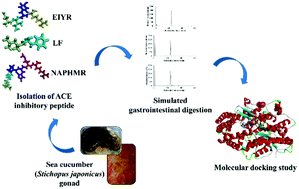In this study, production of bioactive peptides with angiotensin converting enzyme (ACE) inhibitory activity from sea cucumber (Stichopus japonicus) gonad using commercial protamex was optimised by response surface methodology (RSM). As a result, the optimal condition to achieve the highest ACE inhibitory activity in sea cucumber gonad hydrolysate (SCGH) was hydrolysis for 1.95 h and E/S of 0.75%. For further characterisation, three individual peptides (EIYR, LF and NAPHMR) were purified and identified. The peptide NAPHMR showed the highest ACE inhibitory activity with IC50 of 260.22 ± 3.71 μM. NAPHMR was stable against simulated gastrointestinal digestion and revealed no significant cytotoxicity toward Caco-2 cells. Molecular docking study suggested that Arg, His and Asn residues in NAPHMR interact with the S2 pocket or Zn2+ binding motifs of ACE via hydrogen or π-bonds, potentially contributing to ACE inhibitory effect. Sea cucumber gonad is thus a potential resource to produce ACE inhibitory peptides for preparation of functional foods.

